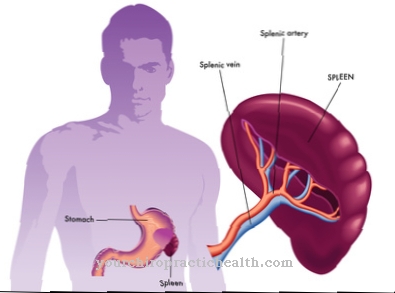A Water retention in the legs shouldn't be underestimated. Because it represents a serious health problem due to the penetration of water into the tissue.
What is water in the legs?

When a patient has water in their legs it is known as edema. In most cases, this is shown by swelling of the leg tissue.
Edema usually occurs only briefly and is locally limited. They can be diagnosed by putting pressure on the affected areas. If the dent persists for a certain time after the pressure has been stopped, this indicates edema.
causes
Water in the legs can have many different causes. Water retention can be a symptom of a serious illness, such as heart or kidney disease.
A distinction must be made here whether the swelling occurs on one or both legs. In the legs, the causes are venous weakness, lymphedema, insufficient blood flow, infections or tumors.
There are many possible causes of swelling in both legs: Sedentary lifestyle, lipoedema, disorders of the heart and kidney function, liver diseases, protein deficiency edema, diabetes or eating disorders can be the causes. But allergies, poisoning, hormonal disorders, the consequences of operations and certain medications can also cause swelling of the legs.
You can find your medication here
➔ Medicines against edema and water retentionDiseases with this symptom
- Heart failure
- Menopause
- high blood pressure
- Liver disease
- Quincke's edema
- Hormonal imbalances
- eating disorder
- Renal failure
- Hypothyroidism
- Diabetes mellitus
- Circulatory disorders
- Chronic venous insufficiency
- Vein weakness
- Inflammation of the kidneys
- Adrenal insufficiency
- allergy
- Lymphatic filariasis
- Lymphedema
Diagnosis & course
For this reason, a comprehensive health check should be carried out if there is water in the legs. In any case, a healthy lifestyle is important. So if you do something against obesity and take regular exercise, you have already done a lot for prevention. Once that happens, a doctor should be consulted quickly so that the causes can be clarified.
The doctor will first take a close look at the feet and legs and then carry out the appropriate therapy. If the water retention has existed for a long time, functional disorders of the legs are possible. If the water retention leads to a very high level of stress on the person affected, the development of depressive symptoms is also possible.
As part of the diagnosis, the particular medical history of the person affected is also determined. This is followed by a detailed examination to find out the cause of the underlying disease. Afterwards, a decision can be made about the type of treatment.
Complications
Water in the legs is caused by different causes, which can have different complications. Typically, there is an increased incidence of edema when the kidneys are weak (renal failure). The kidneys can also no longer remove enough toxins from the body, so that poisoning can occur (uremia). This can lead to a uremic coma.
Furthermore, not enough acid is excreted, so that the blood becomes acidic. As a result, the body has less free calcium available, so the body experiences a lot more cramps.In the worst cases, the affected person has to undergo dialysis or even a kidney transplant, which severely reduces the quality of life.
Liver weakness (liver insufficiency) also leads to increased water retention in the legs. The liver can develop into cirrhosis. The synthesis capacity of the liver is severely disadvantaged. It no longer produces enough proteins, which on the one hand increases the bleeding time and also promotes the development of edema.
In addition, more water can accumulate in the abdominal cavity, causing ascites. The scarring of the liver also redirects the blood flow and more blood reaches the spleen, where it is increasingly broken down. Anemia and painful enlargement of the spleen (splenomegaly) are the result. In the worst case, liver cirrhosis can turn into liver cancer (liver carcinoma).
When should you go to the doctor?
Water retention in the legs can have many causes: standing for a long time, being overweight, genetic predisposition, medication such as antihypertensive drugs, heat or too much fluid intake. But there can also be serious health problems behind the complaints.
A doctor should be consulted if self-help measures do not work in the long term. If it is not enough to put your legs up regularly, to apply cooling creams such as vine leaf extract or essential oils such as eucalyptus and Japanese mint oil, to lose excess weight and to exercise regularly, a visit to the doctor is urgently necessary. Water retention in the legs should not be played down, because vein damage can occur over time. It can also be a symptom of another disease.
If all self-help measures fail, there may be serious medical causes. Water in the legs can, for example, be due to kidney problems or damaged lymph. The first step should always be to see a general practitioner, who may be able to remedy the situation, for example by having a blood count taken or by prescribing medication that flushes excess water out of the body. If the suspicion that another illness is present is confirmed, the family doctor can arrange referrals to special specialists who will investigate the causes. Symptomatic treatment is then insufficient.
Doctors & therapists in your area
Treatment & Therapy
The treatment must of course be based on the underlying disease. Successful treatment is therefore the best and most effective remedy for swollen feet. However, a healthy lifestyle is also very important. Above all, risk factors must be identified and eliminated.
These include, for example, alcohol and nicotine, as these substances can damage blood vessels. Regular physical exercise is also important. Everyone should find the sport that is fun and enjoyable here. However, consultation with the attending physician is mandatory. If you have heart failure, you may choose a different sport than someone with varicose veins. There are a variety of sports that can be easily integrated into everyday life; for example swimming, but also jogging and cycling.
Swimming has the main advantage that it also has a very positive effect on the leg muscles. Since most swimming pools are also open in the evening, this sport can be easily integrated into everyday life. Cycling and jogging are also highly recommended. Anyone who cycles to work every day has already done a lot for their fitness. Further measures may also be necessary as required. Little exercises in between can help when you sit for a long time. Because even long periods of sitting can cause the blood to sink into the legs and cause corresponding swelling.
This is often a big problem, especially when traveling by plane. You can counteract this by using compression stockings and occasionally changing your leg posture. In any case, some relaxation phases should be built into everyday life. Because psychological stress and emotional pressure can also exacerbate existing ailments and thus also represent considerable risk factors.
Outlook & forecast
At first glance, water in the legs is not a clinical picture, which must be examined or treated by a doctor. Since water in the legs is only a symptom of a certain underlying disease, an exact outlook and prognosis are very difficult to predict. Many affected people with water in their legs have been in the hot sun for long periods of time. If a permanent sitting position is added, water can form in the legs very quickly. However, the accumulation of water in the legs should completely disappear on its own after several hours.
In some cases, however, there is also an underlying disease, so that a doctor should be consulted if there is water retention. In such a case, not only will the legs become thicker, but there will also be permanent pain in the legs. If, for example, there is a venous disease, the water no longer flows back from the legs. Blood accumulates in the legs, which can lead to circulatory problems.
If you want to counteract this clinical picture quickly and effectively, you should consult a doctor immediately. The accumulation of water in the legs can only be combated quickly and effectively with appropriate medication.
You can find your medication here
➔ Medicines against edema and water retentionprevention
The best, of course, is good prevention. Treatment measures already mentioned also apply to prevention. Anyone who is regularly active in sports and also otherwise has a healthy lifestyle has already done a lot for their health.
After all, obesity, smoking and alcohol are one of the biggest risk factors for swelling in the legs. A regular health check by your family doctor is particularly useful from the age of 35.
You can do that yourself
Water retention in the legs can be avoided with some help. Those affected should drink a lot - drinking 2-3 liters of water a day promotes the removal of waste products and lymphatic fluids. Alternating showers also help, because alternating warm and cold water showers is ideal for detoxifying the legs. Those affected begin by showering their legs for about two minutes and then switch to cold. The procedure should be repeated several times - about three to four times.
Lying up helps very well against water in the legs. As often as possible, the legs should be raised - the relief of the legs can be felt relatively quickly. Wearing compression stockings is advisable for those who have to sit a lot. An orthopedic technician makes the corresponding stockings. In many cases the health insurance company will cover the costs.
As a support, the legs should be regularly rubbed with detoxifying ointments. A pharmacist will advise which creams are suitable. The effect can be enhanced by wrapping the legs with conventional cling film and storing them up overnight. Lymph drainage is also purifying. This special massage technique can be learned and used on yourself. Medicines to drain the legs should only be taken after consulting a doctor.



























